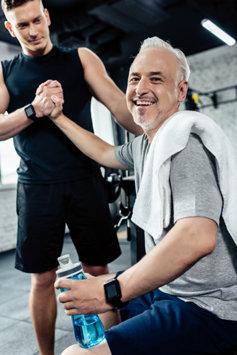Hitting the Gym – Why Intensive Exercise Is Beneficial to Recovery

When people struggle with addiction enter recovery and come out the other side clean and sober, they usually elect to make changes in their day-to-day lives. They want to avoid backsliding into the same toxic habits once again, and so they often completely restructure their days to include only healthy, active, positive, and sensible life choices.
One of the most common activities that recovering addicts engage in is exercise. More specifically, recovering addicts often find a gym and get involved in pretty intensive workout programs, such as weightlifting, cardiovascular conditioning, Yoga, Pilates, cycling, HIIT (High-Intensity Interval Training), etc.
Recovering addicts do this for a variety of reasons. “Hitting the gym” gets them back in shape, repairs damage to the body, and helps clear the mind. And perhaps best of all, gym sessions help improve mood and reduce physical pain symptoms.
It’s All in the Endorphins
You may have heard of the fabled, natural painkillers that our bodies actually make. It might have sounded a little fictional at first. But yes, those grade school biology lessons were accurate. The human body produces a chemical called endorphins. Not only does the production of endorphins send a wave of euphoric calm and contentment over the body, but endorphins also serve to block pain receptors in the brain. This helps to shield the body from the physical sensations of pain.
“Endorphins interact with the opiate receptors in the brain to reduce our perception of pain and act similarly to drugs such as morphine and codeine…”
MedicineNet defines endorphins quite well: “Endorphins function to transmit electrical signals within the nervous system. Endorphins can be found in the pituitary gland, in other parts of the brain, or distributed throughout the nervous system. Endorphins interact with the opiate receptors in the brain to reduce our perception of pain and act similarly to drugs such as morphine and codeine. In contrast to the opiate drugs, however, activation of the opiate receptors by the body’s endorphins does not lead to addiction or dependence.”
If there were ever a healthy way to mask pain, it would be via the release of endorphins. Endorphins do not fully close the body off to sensations of pain, not like heavy drugs do. Instead, endorphins just reduce the sensations of pain, all while helping the individual to feel a whole lot better emotionally. When people feel better in general, when they are getting into better shape, when they feel better physically, and when they’re not feeling so much pain, they’re a lot less likely to experiment with drugs and alcohol. That’s why regular exercise is so important for recovering addicts.
New Research Suggests the Pain-Relieving Effect of Consistent Exercise

As we know, a large percentage of those who struggle with addiction initially sought out substances as a coping mechanism for physical discomfort. Physical pain is a big part of why people turn to alcohol, and it’s almost the sole reason why people use opiate painkillers, whether they have a prescription for them or not. Both alcohol and painkillers can be and are addictive, which is why thousands, if not millions of people who struggle with chronic pain, are also struggling addicts or recovering addicts.
People who are in recovery and who still struggle with chronic pain can benefit immensely from regular workouts. Not only is a gym schedule a great way to stay sober for the reasons we discussed earlier, but it would also appear that the correct gym program can help pain patients live a pain-free (or at least a less painful) life.
An organization called Barbell Medicine is pioneering safe, effective, body-friendly exercise regimens for people who struggle with persistent pain. According to their literature, exercise can be utilized to reduce pain. The organization combines the science of endorphin release with safe and effective workouts to maximize pain relief while minimizing risk for injury. And with that last part in mind, the authors strongly suggest that pain patients seek the help of an expert coach or trainer, someone who understands the inner workings of physical pain and how exercise can reduce pain.
While it’s true that exercise can cause pain if one is not careful, the experts at Barbell Medicine believe that a small degree of discomfort in the gym is not harmful if the long-term goals are towards activities that reduce pain. Quoting their literature, “We do know that it’s ok to allow patients dealing with persistent pain to exercise with pain and there may be some short-term benefits in allowing such an approach by decreasing kinesiophobia, instilling self-efficacy, and teaching that pain doesn’t equal tissue damage necessitating avoidance for protection.”
The Value of the “Gym Sesh” - Why Recovering Addicts Should Consider a Gym Schedule

It would seem that there are near-infinite benefits to exercising. Not only can a good hour in the gym, several times per week, work wonders on the mind, thought processes, and physical health of a recovering addict, but the correct gym regimen can even help recovering addicts get a handle on physical pain.
And that’s the beautiful thing about a good workout. It accomplishes multiple goals at once. A good exercise session can:
- Clear one’s mind and thoughts
- Improve heart health and general cardiovascular function
- Improve respiratory function
- Improve organ function
- Burn calories and builds muscle
- Help rebuild muscle tissue and shed excess weight
- Help restrengthen limbs and muscles that have atrophied from consistent drug use
- Assist in reducing pain by releasing endorphins
- Produce a natural high (a natural state of euphoria indicative of taking the right steps with one’s body and overall health, not the wrong ones).
For those who are still actively using drugs and alcohol, they need to seek the help of a residential addiction treatment center. But for those who are in recovery and who are looking for healthier life choices and healthier coping strategies for a better life in general, a gym membership and some regular exercise might be the exact right choice.
Sources:
- https://www.medicinenet.com/endorphins_natural_pain_and_stress_fighters/views.htm
- https://www.barbellmedicine.com/blog/exercise-for-persistent-pain-populations-highly-recommended-but-do-we-know-the-dosage/
- https://www.spine-health.com/blog/14-natural-pain-relievers
Reviewed by Claire Pinelli, ICAADC, CCS, LADC, RAS, MCAP


